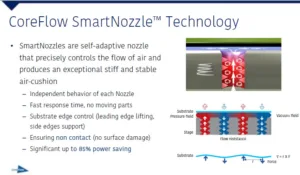 Eric Joely is CEO of CoreFlow which makes handling solutions for thin and flexible OLED substrates. The company has been around since 1999 and has over 800 installations.
Eric Joely is CEO of CoreFlow which makes handling solutions for thin and flexible OLED substrates. The company has been around since 1999 and has over 800 installations.
Handling very thin substrates is very difficult not only with the final display, but with each individual layer as the materials are brought into the production process. CoreFlow uses a vacuum to create motion in the substrate with no physical contact (more later)
There are three approaches to flexible manufacture. Carrier glass, started by Samsung, is the current process, while the second uses individual sheets of polymer, which is a technique that is likely to become more common. Carrier glass is easiest and protects the bottom of the display using the glass.
Making the display directly onto polymers or glass is more efficient, but you can’t use the same equipment. CoreFlow is already working on 0.1mm glass. However, with 0.7mm glass you may have sag of a couple of mm between rolls, but with very thin glass that might get to, for example, 14mm, so normal handling with rollers cannot be used.
Roll to roll is attractive and should be fast for processing, but wrinkles and other defects can be caused quite easily.
The SmartNozzle technology uses a combination of blowing and vacuum to hold the substrate in place
CoreFlow uses its key ‘SmartNozzle’ technology that produces a flow of air that has a very stiff and stable air cushion. The nozzles work as pressure or vacuum sources, so with multiple nozzles, the substrate is held between these two different forces. This ensures non-contact. The key is avoiding damage to the edges of the glass and the company has a patent method to avoid edge damage. Although substrates start as flat, after processing they can get quite deformed and that makes non-contact very difficult to guarantee. CoreFlow said that compared to other methods for moving glass used by ‘a major glass supplier’, the energy used can be reduced by 85%.
To keep the leading edge away from the surface, pressure nozzles are used only to keep the front edge away from the surface, with the vacuum only cutting in when the substrate is over the nozzle, so the front edge is always slightly high. CoreFlow calls this the “Cobra” process.
Roll to roll has been an aim for a long time in the display business. CoreFlow can use rollers with the nozzles so that there is no contact, even in a roll-to-roll processing.
In passing, Joely said that Kateeva used to have a good image on its website with a CoreFlow platform.

